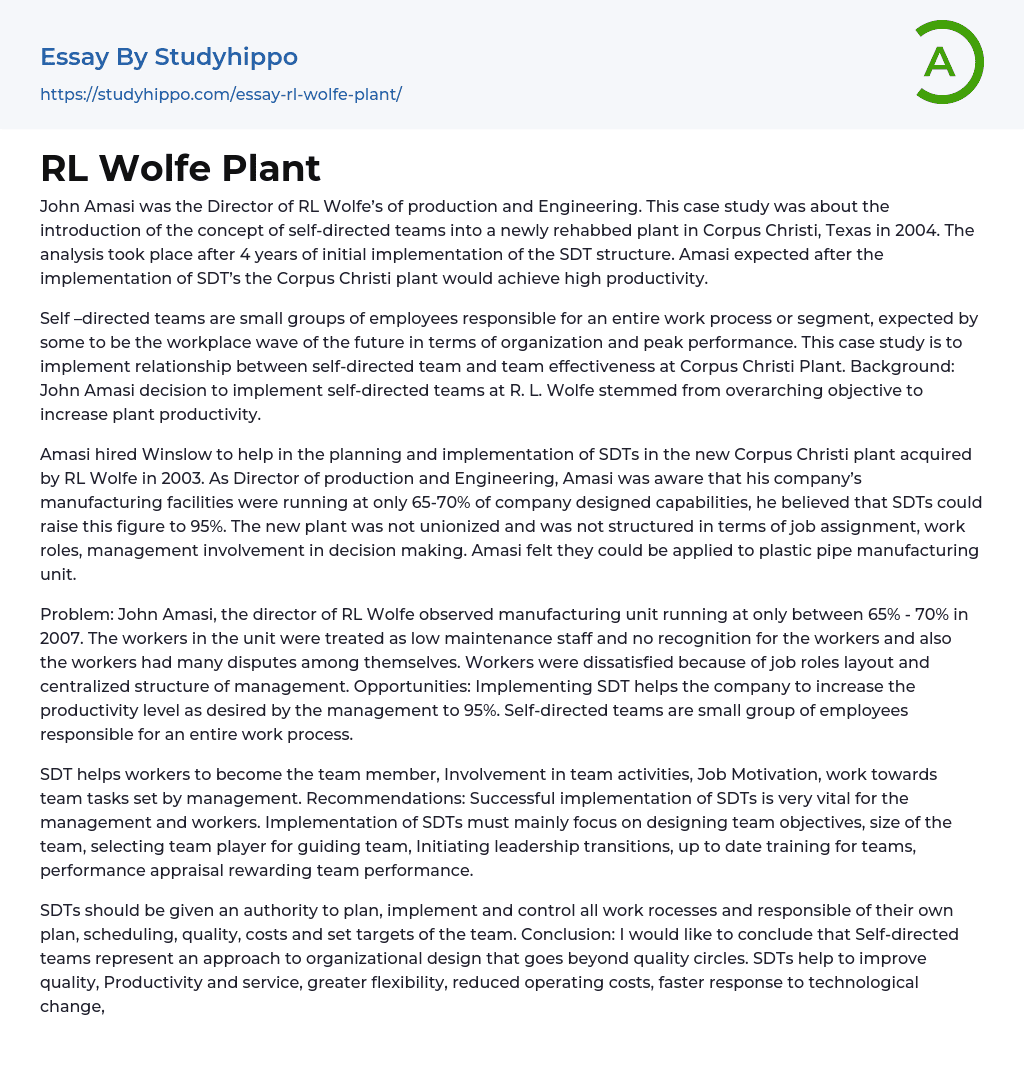John Amasi was the Director of RL Wolfe’s of production and Engineering. This case study was about the introduction of the concept of self-directed teams into a newly rehabbed plant in Corpus Christi, Texas in 2004. The analysis took place after 4 years of initial implementation of the SDT structure. Amasi expected after the implementation of SDT’s the Corpus Christi plant would achieve high productivity.
Self –directed teams are small groups of employees responsible for an entire work process or segment, expected by some to be the workplace wave of the future in terms of organization and peak performance. This case study is to implement relationship between self-directed team and team effectiveness at Corpus Christi Plant. Background: John Amasi decision to implement self-directed teams at R. L. Wolfe stemmed from overarching objecti
...ve to increase plant productivity.
Amasi hired Winslow to help in the planning and implementation of SDTs in the new Corpus Christi plant acquired by RL Wolfe in 2003. As Director of production and Engineering, Amasi was aware that his company’s manufacturing facilities were running at only 65-70% of company designed capabilities, he believed that SDTs could raise this figure to 95%. The new plant was not unionized and was not structured in terms of job assignment, work roles, management involvement in decision making. Amasi felt they could be applied to plastic pipe manufacturing unit.
Problem: John Amasi, the director of RL Wolfe observed manufacturing unit running at only between 65% - 70% in 2007. The workers in the unit were treated as low maintenance staff and no recognition for the workers and also the workers had many dispute
among themselves. Workers were dissatisfied because of job roles layout and centralized structure of management. Opportunities: Implementing SDT helps the company to increase the productivity level as desired by the management to 95%. Self-directed teams are small group of employees responsible for an entire work process.
SDT helps workers to become the team member, Involvement in team activities, Job Motivation, work towards team tasks set by management. Recommendations: Successful implementation of SDTs is very vital for the management and workers. Implementation of SDTs must mainly focus on designing team objectives, size of the team, selecting team player for guiding team, Initiating leadership transitions, up to date training for teams, performance appraisal rewarding team performance.
SDTs should be given an authority to plan, implement and control all work rocesses and responsible of their own plan, scheduling, quality, costs and set targets of the team. Conclusion: I would like to conclude that Self-directed teams represent an approach to organizational design that goes beyond quality circles. SDTs help to improve quality, Productivity and service, greater flexibility, reduced operating costs, faster response to technological change, better response to workers’ value, increase employee commitment to the organization ability to attain and retain quality workers.
- Auction essays
- Balanced Scorecard essays
- Business Plans essays
- Expense essays
- Income essays
- Net Income essays
- Security Guard essays
- Singapore Airlines essays
- Battle essays
- Intranet essays
- Maintenance essays
- Simulation essays
- Inn essays
- Chief Executive Officer essays
- Convenience Store essays
- Firm essays
- Training And Development essays
- Unilever essays
- Variable Cost essays
- Virgin Group essays
- Bargaining essays
- Entity essays
- Pest analysis essays
- Leadership and Management essays
- Change Management essays
- Project Management essays
- Knowledge Management essays
- Operations Management essays
- Quality Management essays
- Risk Management essays
- Scientific Management essays
- supply chain management essays
- Performance Management essays
- Time Management essays
- Brand Management essays
- Total Quality Management essays
- Risk essays
- Manager essays
- Leadership essays
- Business Ethics essays
- Board Of Directors essays
- Product Management essays
- Comparative Analysis essays
- Decision Making essays
- Dispute Resolution essays
- Stress Management essays
- Business Management essays
- Brand Equity essays
- Branding essays
- Nike, Inc. essays




